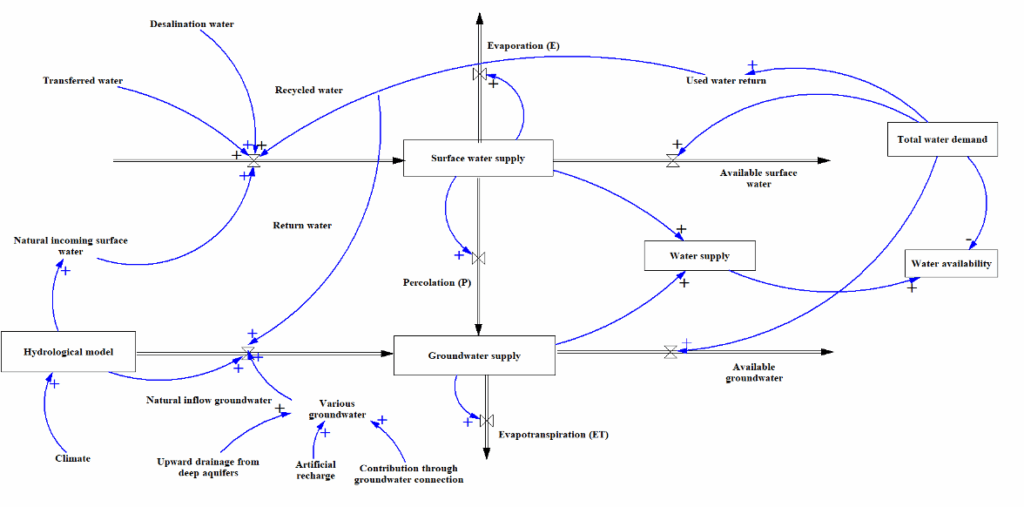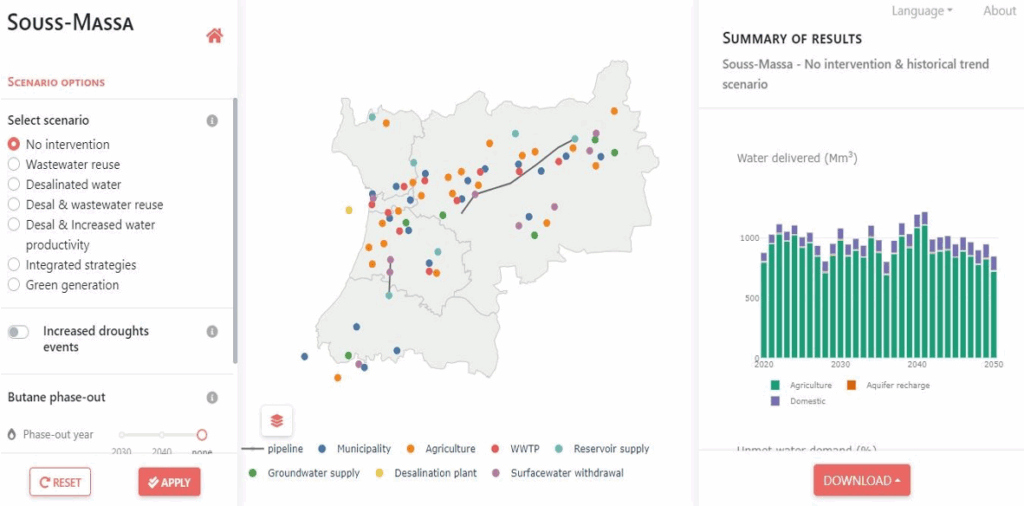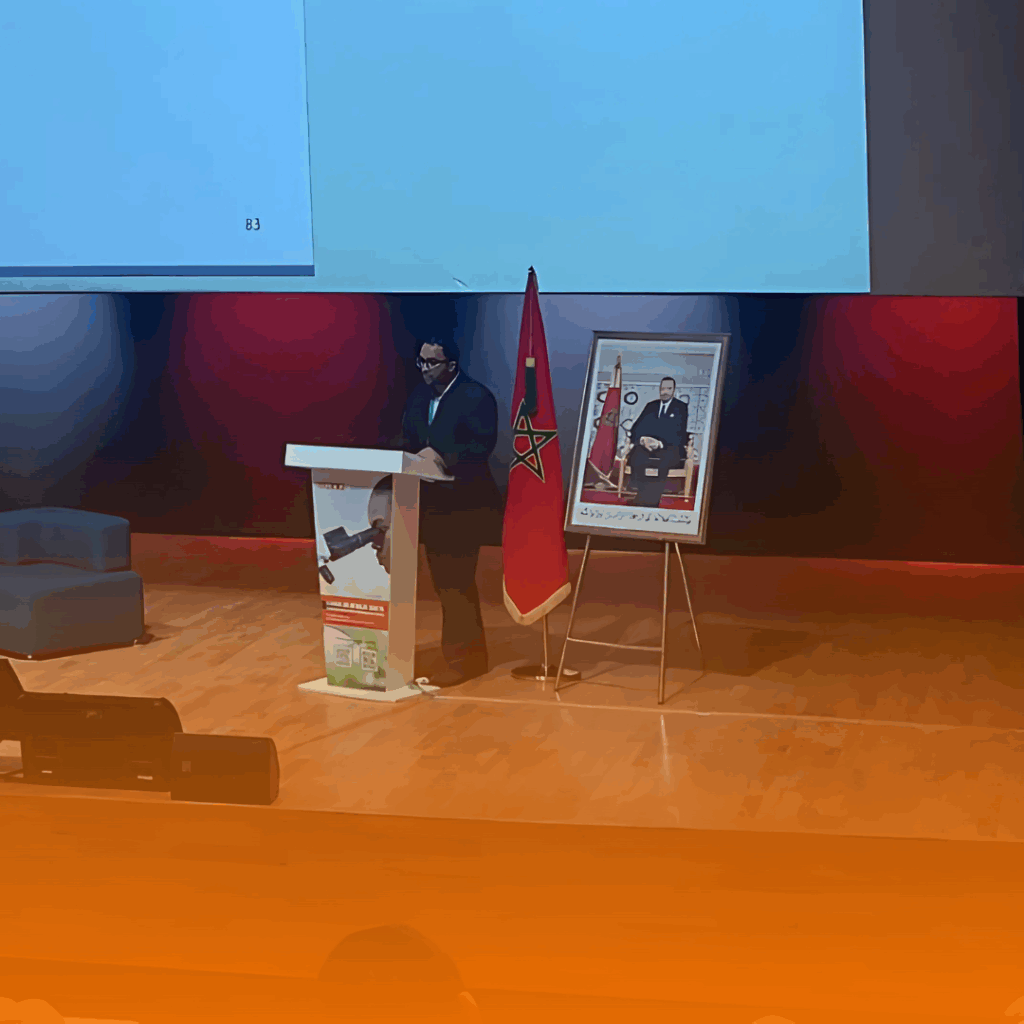System Dynamics as a Game-Changer for Sustainable Water Resource Management
UM6P Impact | Science in Action #11

In Morocco, water is no longer a support system but the stress factor at the heart of the equation. Once considered a renewable and easily accessible resource, it is now the main constraint weighing on national priorities. Aquifers are collapsing under the combined weight of agricultural pressure and climate instability. Coastal areas in the Souss-Massa basin or the Gharb plain are facing salinization, which is silently seeping into the soil, killing fruit trees and jeopardizing the livelihoods of entire communities. Rainfall, once seasonal and predictable, is becoming increasingly irregular, concentrated in short, violent bursts, or disappearing altogether. Rural communities wait longer each year for the rains. Urban areas are increasingly dependent on transfer systems and mega-desalination projects, while social tensions intensify during periods of high demand. The numbers are not abstract: they translate into uncertainty for farmers, risks for cities, and stress for already strained institutions. And yet, the response remains trapped in a framework that assumes that better data alone is enough to improve governance. National dashboards are becoming more sophisticated, algorithms more refined, and forecasts more granular. But something fundamental is missing: we model water flow without modeling the behavior of systems.
Our projections are based on data (precipitation, consumption, storage), but do not take into account the adaptive responses of populations, frictions between agencies, and the unintended side effects of policies. This explains why, despite national water plans and significant public investment, the crisis continues to worsen. Morocco does not suffer from ignorance, but from oversimplification. Water management continues to be treated as a hydraulic problem to be optimized, rather than as a socio-environmental dynamic to be understood. It is not a question of abandoning technology but of integrating it into a broader understanding of complexity.
When farmers dig deeper wells, it is not just a technical act, but a political response to scarcity. When municipalities delay infrastructure modernization, it creates cumulative vulnerabilities. When institutions operate in silos, even the most ambitious strategies lose their coherence. In this context, measuring more can mean seeing less, if we do not understand what to look for.
At the International Water Research Institute (IWRI) of the University Mohammed VI Polytechnic, this paradox is reframed as a research challenge: how can we move from water accounting to water systems thinking?
How can we rethink models not only as calculators but also as tools for navigating uncertainty and building resilience?

When Models Simplify What Reality Complicates
Traditional water management models, however sophisticated, are designed to simplify. They reduce reality to a set of variables: precipitation comes in, consumption goes out. Tools such as WEAP, MODFLOW, or SWAT provide valuable simulations of water flows and balances. But in a context such as Morocco’s, where human behavior, institutional inertia, and climate volatility intersect, these tools fall short. They can simulate the amount of water remaining in a dam, but not how long a regulatory delay will delay its release. They can optimize irrigation efficiency, without taking into account that increased efficiency can lead to crop expansion and, paradoxically, increased pressure on aquifers. These models are not wrong, but they are incomplete. They provide a static picture of a system that moves, reacts, and evolves.
At UM6P, researcher Ayoub Guemouria, under the direction of Professors Abdelghani Chehbouni and Lhoussaine Bouchaou, is shifting the lens. For them, the starting point is not only hydrology, but also interaction. Because water is not only used, it is also contested, negotiated, redirected, and disputed. A policy that seems optimal on paper can collapse in practice due to unmodeled variables: a farmer’s mistrust, a mayor’s reelection cycle, an informal groundwater market. None of these elements fit neatly into a supply and demand curve, but all influence the outcome. This is where conventional tools reveal their limitations: they are designed for known relationships, not emerging ones; for systems in equilibrium, not turbulent ones. In other words, they simplify what reality insists on complicating.
The real problem is that water governance in Morocco, and across much of Africa, is not simply a technical issue. It is a constantly evolving field. A drought shifts patterns. A subsidy changes crop choices. A delay in infrastructure creates unintended dependencies. And these effects cascade. But traditional models rarely trace these cascades. They are structurally blind to feedback loops. The result? Decisions are made with a partial vision. Interventions that seem rational lead to irrational consequences. And technically sound policies prove to be socially fragile. Guemouria’s work does not merely criticize this situation; it proposes an alternative logic. A logic in which models do not begin with prediction, but with structure. Not with volume, but with dynamics. And not with certainty, but with learning.

From Isolated Variables to Interconnected Futures

System Dynamics is not a model; it’s a way of thinking. It sees water not as a stock to be managed, but as a flow shaped by institutions, behavior and time. Unlike conventional tools, System Dynamics doesn’t seek to iron out complexity, it embraces it.
Using feedback loops, it captures how one intervention today creates multiple consequences tomorrow, some reinforcing, others balancing, all interdependent. It allows us to map and simulate the real mechanisms of policy failure and success.
In Souss-Massa, Guemouria used System Dynamics to simulate what would happen if irrigated areas continued to expand under current subsidy schemes. The result was counter-intuitive but revealing: more efficient water use led to more land use, which led to more extraction, which eventually depleted aquifers faster. The model revealed a dangerous loop, hidden in traditional projections, but essential to systemic resilience.
It’s not a theoretical question. It’s a strategic question. Indeed, water scarcity is not just the result of nature, it is also the result of choices. If we don’t model these choices systemically, we risk repeating cycles of false solutions.
System Dynamics offers decision-makers a holistic sandbox in which to test trade-offs: What happens if tariffs rise? If infrastructure is delayed? If urban demand explodes? But above all, it invites stakeholders – urban planners, farmers, and basin authorities – to co-build these simulations.
It becomes a collective space for exploration, negotiation and foresight. It’s not a calculator, but a conversation.
This approach is particularly crucial in the Moroccan context, where institutional overlaps and territorial asymmetries complicate top-down planning. Basin agencies can manage resources, but agriculture, industry and housing are managed by other actors.
Traditional models cannot reconcile these realities, but System Dynamics can simulate them together. It allows Morocco to build not only better water models, but also better governance models. And that’s what makes this method so relevant for the whole of Africa. Because the real challenge is not scarcity, but inadequacy: between strategy and implementation, between technical solutions and social acceptance, between data and decisions. And in this space of inadequacy, System Dynamics offers not answers, but structure.
Where :
R: Reinforcing loop
B: Balancing loop
Blue Arrows: Causal links in the core system
Red Arrows: External driver—climate change impact
Positive causal link: An increase (or decrease) in the first variable causes the same direction of change in the second variable.

Negative causal link – : An increase in the first variable causes the opposite change in the second variable.

Where:
In the System Dynamics model, water resources are represented through interconnected stocks, flows, and drivers. Surface water and groundwater constitute the two primary reservoirs of available storage. Together, they determine the total water supply delivered to users, and the remaining volume after use and losses is what defines the system’s current availability. Water inputs come from natural inflows such as rainfall and aquifer recharge, but also from non-conventional sources including recycled water, desalinated water, and inter-basin transfers. Additionally, human-induced processes like artificial recharge and deep drainage contribute to restoring groundwater levels.
However, the system also experiences significant losses, primarily through evaporation, evapotranspiration, and percolation — where water infiltrates from the surface into underground layers.
On the demand side, the model accounts for total water needs across all sectors and assesses how effectively supply matches that demand. Finally, a hydrological model integrates all these variables to simulate water flows in response to climatic and environmental conditions.
Rethinking Governance, One Simulation at a Time
Beyond its technical advantages, the strength of System Dynamics lies in its humility. It does not provide the optimal solution, but helps us explore it more judiciously. In a world where surprises are becoming the norm, this ability to anticipate – rather than control – becomes essential. Particularly in the field of water governance, where delays are costly and decisions irreversible. By modeling not only outcomes but also interdependencies, System Dynamics restores an element that planning has often forgotten: time. It helps us to act not only according to need, but also at the pace of institutions, ecosystems and society.
Managing the Future Before It Arrives
UM6P doesn’t treat System Dynamics as an academic curiosity. It integrates it as a strategic compass. In its research, partnerships and training of future engineers and political experts, UM6P places complexity at the heart of resilience. The logic is clear: Morocco cannot manage the future with models from the past. In a context where climate change is accelerating uncertainties, where demographic trends are reshaping demand, and where institutional trust is a scarce resource, resilience is more than infrastructure – it’s anticipation
This is exactly what System Dynamics offers. It enables us to move from water management to water intelligence. From volume forecasting to behavior simulation. From reactive governance to adaptive planning. The urgency is not in the data, it’s in the design. The next ten years will determine whether Morocco can secure its water future. And this objective cannot be achieved by hydraulic logic alone. We need a systemic logic. The work of Guemouria and his team offers not only a tool, but also a mindset
The question is no longer “How much water do we have?” but “How do we make decisions in a world where everything is connected, deferred and evolving?” This is the future UM6P is preparing for. A future in which water governance is no longer a sector, but a system of systems. And in this future, System Dynamics is not optional, it is essential.
Water management can be compared to managing a bank account: if liabilities (agricultural, industrial and domestic water demands) exceed assets (conventional and non-conventional water resources), the balance (water reserves) is rapidly depleted, leading to a critical overdraft. Like a careless saver, poor water management inevitably leads to shortages. But unlike a bank, nature offers neither unlimited credit nor low-interest loans. Hence the importance of rigorous planning and rational use of resources, on pain of seeing our “water account” go into ecological bankruptcy!

About the Research – Ayoub Guemouria’s System Dynamics Approach

Ayoub Guemouria is a PhD Candidate at the International Water Research Institute (IWRI) of the University Mohammed VI Polytechnic (UM6P), Morocco.
His research focuses on the integration of System Dynamics, complex systems thinking, and optimization modeling to better understand coupled human–natural systems across multiple scales.
His PhD aims to promote evidence-based water governance and guide policy development through innovative simulation and modeling techniques.
Beyond the Model: Rethinking Water Governance at UM6P
In the face of intensifying water stress, the Mohammed VI Polytechnic University (UM6P) is positioning itself as a leading actor in water intelligence. At the heart of this ambition lies the work of Ayoub Guemouria, PhD researcher at the International Water Research Institute (IWRI), whose research proposes a radical shift in the way we model, simulate, and govern water resources.
His approach does not stop at hydrological equations. It integrates System Dynamics, complex systems thinking, and governance modeling to confront a central question: how can institutions anticipate systemic risks rather than merely react to scarcity? By simulating feedback loops, adaptive behaviors, and institutional frictions, his work opens new pathways for resilience in the Souss-Massa region—and far beyond.
This research is fully aligned with UM6P’s mission: to provide science-based, locally grounded, and globally relevant solutions to pressing challenges. Through this lens, modeling becomes more than a tool—it becomes a space for decision-making, foresight, and negotiation.
The complete peer-reviewed study is available in the journal Water (MDPI), and provides an in-depth look into the System Dynamics framework applied to Morocco’s water governance:
This article is part of a growing body of work emerging from UM6P that redefines the role of science in public policy—bridging data, complexity, and institutional change.

Leave a Reply